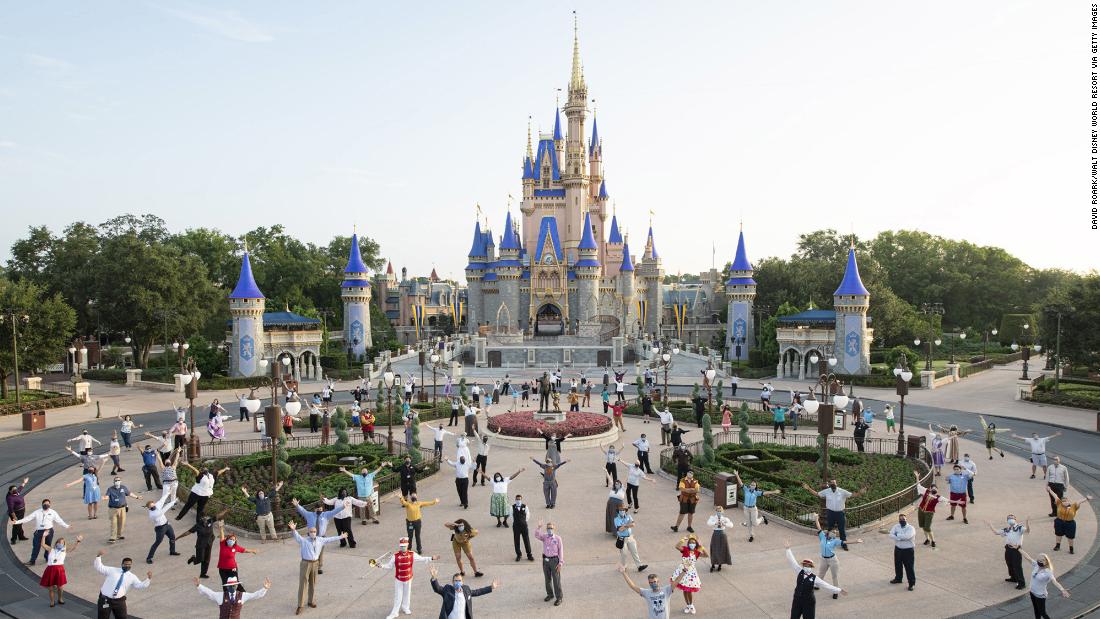Business
Disney Has A Price Problem. It Has Ambitious Plans To Fix That

Disney just revealed a massive slate of projects for parks and cruises in front of 12,000 of its most devoted fans, who will most likely return to Disney’s theme parks to experience those new offers, regardless of the cost.
However, whether a frequent visitor or a first-timer, Disney’s price increases and a global inflation issue have left many families unable to afford journeys to witness the technological feats and fantasy immersion that the “Happiest Place on Earth” promises.
Disney Has A Price Problem. It Has Ambitious Plans To Fix That
“It is not news that a Disney trip is expensive, but the magnitude and speed of price increases over roughly the past five years was jarring to many respondents, and we do not believe similar increases over roughly the next five years are feasible,” a Raymond James survey of 20 Disney “superfans,” travel agents, and Orlando-area business owners found.
In its August 7 earnings report, Disney cautioned that domestic park attendance was falling behind projections as customers become more price-conscious. Profits at US parks decreased in the last quarter, from April to July. On the company’s earnings call, Hugh Johnston, Disney’s CFO, stated that similar results may be expected in the coming quarters.
In an interview with CNN, Josh D’Amaro, chairperson of Walt Disney Parks and Resorts, stated that the firm will continue to offer a variety of pricing and alternatives to retain visitors.
“What we will continue to do is make sure we provide as much access and flexibility as we possibly can, so as many of our fans can experience these things as possible,” D’Amaro told reporters.
In response to criticism about excessive prices, Disney has continuously promoted lower-cost ticket alternatives and “value season” bargains at its resort hotels to encourage families to visit, even with a limited budget.

CNN Image
Disney is one of many corporations facing declining client spending. The travel industry’s demand is cooling, signaling the end of the “revenge travel” fad that emerged in the months following the lifting of pandemic restrictions. Consumers spent more freely with stimulus money in their bank accounts, making up for a year of missed vacations.
D’Amaro expressed confidence that Disney will be able to overcome these challenges.
“We have proven ourselves to be incredibly adept at managing through situations where there’s some change in consumer behaviour,” he told me. “We have even more sophistication in our ability to deal with any of these fluctuations, whether it’s through precise promotional deployment, or management of cost or engagement with our guests.”
The new announcements, promising guests the opportunity to ride through the “Encanto” casita, fight a battle in Wakanda, or experience an ominous villain-themed land, are all part of Disney’s $60 billion investment in parks and cruises over the next decade—an investment that will need to be paid for overtime with consumer dollars.
However, according to Tom Bricker, co-founder of DisneyTouristBlog.com, Disney’s big investment does not guarantee that ticket prices will be raised immediately. This is basic economics.
“Costs will rise as demand increases, which may occur as a result of new additions. Right now, demand is flat or dropping,” Bricker added, referring to the most recent earnings report, which projected the decrease in attendance may endure until 2025. “The opening of Universal’s Epic Universe in 2025 will most likely have a detrimental influence on Walt Disney World attendance. It will not be catastrophic—Epic Universe will attract more visitors to Orlando, who will also visit Disney—but it will be detrimental in the short run.”
As a result, Bricker said park guests should expect more parades events and discounts in the coming year as Disney strives to keep people visiting, especially since the new regions and rides will be under development for some time.
Even with this, the current price of Disney tickets compared to previous years is prohibitively expensive for some families.
Shortly after Disneyland in California opened in 1955, visitors could pay $2.50 for entry plus ten rides. Adjusted for inflation, the $2.50 would be worth $28.74 today. When Disney World in Florida opened in 1977, entry and a book of tickets for seven rides cost $8. In 2024 dollars, that would be $61.66.
The cheapest one-day tickets to Disneyland and Walt Disney World during the “value” season cost $104 and $116.09, respectively.
However, when the parks opened, admission rates were just a single park with significantly fewer attractions than a Disney guest may enjoy today. Disneyland Resort now includes two parks with over 65 attractions, while Disney World has four theme parks and two water parks, totaling over 150 attractions.
Don Munsil, who runs MouseSavers, a travel website that keeps historical data of Disney rates, highlighted that “value” tickets have climbed by less than 1% each year over the last ten years. However, the number of dates on the calendar when these prices apply has decreased.
On the high end, Munsil said that the most costly single-day ticket to only one park during peak season at Disneyland in California ($194) had climbed by an average of 7% each year over the last decade. A similar peak season ticket at Disney World in Florida ($201.29) has risen by an average of 6.4% yearly.
The hikes in these peak tickets have outpaced inflation during the same period.
According to MouseSavers, tickets for a family of four to hop between the Walt Disney World parks for four days during peak season would cost around $3,098 in 2024, excluding additional services such as access to speedier “Lightning Lanes,” which were formerly free.
That is around double what they cost ten years ago and 3.6 times the amount twenty years ago.
Paid entry to Lightning Lanes, launched at Disney World in 2021, can cost between $17 and $41 per person per day, depending on the park and season.
Certain popular rides are excluded, however. For example, using the Lightening Lane for “Star Wars: Rise of the Resistance” would cost an additional $25 per person.
However, Munsil points out this is the cheapest theme park “express” service available. He stated that Universal’s express pass costs between $105 and $310 per person per day, depending on the number of parks and selections. Cedar Point charges $95 to $120 per guest each day, and Busch Gardens charges $60 to $150 per person, per day.
The fan community complains that this used to be free at Disney parks. Transportation from the Orlando airport to Disney World property was previously free for Disney hotel guests, but this service has been discontinued.
Disney Has A Price Problem. It Has Ambitious Plans To Fix That
Food and souvenirs in the parks are likewise significantly more expensive.
According to the Disney Food Blog, a Mickey ice cream bar cost $2.59 15 years ago. Adjusted for inflation, it should cost $3.78 in 2024, yet the price is $6.29.
Light-up speciality balloons cost $15 in 2015. Adjusting for inflation, that style of balloon would cost $19.60. In 2024, the balloon costs $20. So not everything in the parks is outpacing inflation.
Victoria Wade, the author of the content, said: “In recent years, there has been a feeling that the fans have been nothing more than dollar signs and that our feedback wasn’t taken seriously since the return to normality with the pandemic.”
Wade stated that the perceived volatility of Disney leadership and the addition of previously free paid items and experiences “led to a lack of trust between the company and the community.”
However, Wade stated that the main announcements made at the Disney fan convention, D23, gave her the impression that the corporation is listening to input, such as the addition of a new nighttime parade at Magic Kingdom, which faithful visitors had asked for a long time.
Munsil stated that Disney parks are “expensive, yes, but there’s nothing else on Earth like them.”
SOURCE | CNN
Business
Iconic Tupperware Brands Seeks Chapter 11 Bankruptcy

NEW YORK — Tupperware Brands, which revolutionized food storage decades ago, has filed for Chapter 11 bankruptcy protection.
Tupperware, based in Orlando, Florida, intends to continue operations during the bankruptcy proceedings and will seek court clearance for a sale “in order to protect its iconic brand,” the firm announced shortly before midnight on Tuesday.
The corporation is seeking bankruptcy protection as it attempts to revitalize its operations. Tupperware sales increased slightly during the early stages of the COVID-19 epidemic, but overall sales have been steadily declining since 2018 owing to increased competition. Financial difficulties have continued to mount for the corporation.
Iconic Tupperware Brands Seeks Chapter 11 Bankruptcy
Doubts about Tupperware’s future have persisted for some time. Last year, the company sought extra financing as it warned investors about its capacity to continue operations and the prospect of being delisted from the New York Stock Exchange.
The NYSE issued the company an extra non-compliance warning for failing to publish its annual results with the Securities and Exchange Commission earlier this year. In recent months, Tupperware has continued to raise concerns about its capacity to stay solvent, with an August securities filing citing “significant liquidity challenges.”
Tupperware filed for bankruptcy on Tuesday, reporting more than $1.2 billion in total obligations and $679.5 million in total assets. The company’s shares have plunged 75% this year and finished Tuesday at around 50 cents each.
“The reality is that the decline at Tupperware is not new,” Neil Saunders, managing director of GlobalData, wrote in a commentary on Wednesday. “It is very difficult to see how the brand can get back to its glory days.”
Saunders explained that many consumers have been switching to cheaper home storage brands, and that competition has increased over time, particularly with the advent of online platforms like Temu and retailers like Target beefing up their own home storage and kitchenware brands.
Tupperware’s origins go back to 1946. According to the company’s website, shortly after the Great Depression, chemist Earl Tupper found inspiration while making moulds at a plastics factory, embarking on a mission to create an airtight seal for a plastic container, similar to that on a paint can, to assist families in saving money on food waste.
The brand enjoyed tremendous expansion in the mid-twentieth century, particularly with the introduction of Tupperware parties, which began in 1948. Tupperware parties, in particular, provided many women with the opportunity to run their own businesses from the comfort of their own homes, selling their products to social circles.
The approach worked so successfully that Tupperware finally pulled its products from retailers. In Tuesday’s bankruptcy statement, the firm stated that there are no immediate modifications to Tupperware’s independent sales consultant agreements.
According to court records filed Tuesday, Tupperware now employs over 5,450 people in 41 countries and works with a global sales force of over 465,000 consultants who sell products on a freelance basis in approximately 70 nations.
Tuesday’s announcement also mentioned plans to “further advance Tupperware’s transformation into a digital-first, technology-led company,” potentially indicating a shift towards increased reliance on the brand’s website or more online-focused marketing, though the company did not provide specifics.
In a statement, Tupperware President and CEO Laurie Ann Goldman recognised the company’s recent financial problems and stated that the bankruptcy process is intended to provide “essential flexibility” while it pursues this transformation. She also stated that the brand was not going anywhere.
Iconic Tupperware Brands Seeks Chapter 11 Bankruptcy
“Whether you are a dedicated member of our Tupperware team, sell, cook with, or simply love our Tupperware products, you are a part of our Tupperware family,” Goldman stated in an email. “We plan to continue serving our valued customers with the high-quality products they love and trust throughout this process.”
Goldman, who previously served as CEO of Spanx, was appointed CEO of Tupperware in October 2023, as part of a bigger leadership transition. Over the last year, the corporation has established a new management team.
SOURCE | AP
Business
Facebook Owner Meta Bans Russia State Media Outlets Over ‘Foreign Interference’

LONDON — Meta said it is blocking Russia’s state media organizations from its social media platforms, claiming that the outlets employed misleading strategies to spread Moscow’s misinformation. The Kremlin condemned the news on Tuesday.
The business, which owns Facebook, WhatsApp, and Instagram, announced late Monday that it will implement the restriction over the following few days as part of its attempts to counter Russia’s covert influence operations.
“After careful consideration, we expanded our ongoing enforcement against Russian state media outlets: Rossiya Segodnya, RT and other related entities are now banned from our apps globally for foreign interference activity,” Meta stated in a written statement.
Facebook Owner Meta Bans Russia State Media Outlets Over ‘Foreign Interference’
Dmitry Peskov, Kremlin spokesman, reacted, stating that “such selective actions against Russian media are unacceptable,” and that “Meta with these actions are discrediting themselves.”
“We have a really negative view about this. And this, of course, hinders our chances of normalising relations with Meta,” Peskov told reporters during his regular conference call.
RT, formerly known as Russia Today, and Russia Segodnya both condemned the move.
“It’s cute how there’s a competition in the West — who can try to spank RT the hardest, in order to make themselves look better,” said RT in a statement.
Rossiya Segodnya, the parent corporation of state news agency RIA Novosti and news brands such as Sputnik, stated that Meta’s decision “was not unexpected for us.”
“Meta is a highly politicised organisation. We will continue to work in the countries where we are now present, and this decision will have no impact on our activity,” Rossiya Segodnya stated in a statement.
Meta’s moves came just days after the US announced new sanctions against RT, citing the Kremlin news outlet as being a significant component of Russia’s war machine and efforts to destabilize its democratic enemies.
Last week, US officials said that RT was collaborating with the Russian military and organizing fundraising drives to buy sniper rifles, body armor, and other equipment for soldiers fighting in Ukraine. They further said that RT websites pretended to be credible news sites but were used to promote disinformation and propaganda throughout Europe, Africa, South America, and elsewhere.
Earlier this month, the Biden administration seized Kremlin-run websites and charged two RT workers with sending millions of dollars in covert funding to a Tennessee-based content development company to generate English-language social media videos promoting Kremlin policies.
Moscow has denied the allegations.
Facebook Owner Meta Bans Russia State Media Outlets Over ‘Foreign Interference’
Meta had already taken steps to curb Moscow’s online presence. Since 2020, it has labeled postings and content from state-run media. Two years later, it prohibited Russian state media from running ads and lowering their content in people’s feeds, and the company, along with other social media sites such as YouTube and TikTok, barred European Union users from accessing RT and Sputnik channels after they were sanctioned by Brussels. In 2022, Meta also shut down a vast Russia-based disinformation network that propagated Kremlin talking points about the invasion of Ukraine.
Moscow responded by branding Meta as an extremist group in March 2022, shortly after sending soldiers into Ukraine and restricting Facebook and Instagram. Both sites, as well as Elon Musk’s X, formerly known as Twitter, which is also restricted, were popular among Russians before to the invasion and the accompanying crackdown on independent media and other kinds of critical discourse. The social media services are now only available over virtual private networks.
SOURCE | AP
Business
Instagram Makes Teen Accounts Private As Pressure Mounts On The App To Protect Children

Instagram is making teen accounts private by default in an effort to make the platform safer for minors, amid mounting criticism of how social media affects young people’s lives.
Beginning Tuesday, anybody under the age of 18 who signs up for Instagram in the United States, United Kingdom, Canada, and Australia will be assigned to restricting teen accounts, and those with existing accounts will be transferred over the next 60 days. Teenagers in the European Union will have their accounts updated later this year.
Meta agrees that teens may lie about their age and says they will be required to verify their ages in additional situations, such as when they attempt to register a new account with an adult birthday. The Menlo Park, California company also stated that it is developing technology to detect teen accounts that appear to be adults and immediately place them in limited teen accounts.
Instagram Makes Teen Accounts Private As Pressure Mounts On The App To Protect Children
Teen accounts will be private by default. Private messages are controlled, so teenagers can only receive them from persons they follow or are already linked with. “Sensitive content,” such as footage of individuals fighting or advertisements for cosmetic procedures, will be limited, Meta stated. Teens will also receive notifications if they spend more than 60 minutes on Instagram, and a “sleep mode” will be enabled, which disables notifications and sends auto-replies to direct messages between 10 p.m. and 7 a.m.
These settings will be enabled for all teens, but 16 and 17-year-olds will be able to disable them. Children under the age of 16 must obtain permission from their parents.
“The three concerns we’re hearing from parents are that their teens are seeing content that they don’t want to see or that they’re getting contacted by people they don’t want to be contacted by or that they’re spending too much on the app,” according to Naomi Gleit, head of product at Meta. “So teen accounts is really focused on addressing those three concerns.”
The announcement comes as the firm faces lawsuits from dozens of US states accusing it of endangering young people and contributing to the juvenile mental health crisis by knowingly and deliberately developing features on Instagram and Facebook that addict children to its platforms.
Letitia James, New York Attorney General, called Meta’s statement “an important first step, but much more needs to be done to ensure our kids are protected from the harms of social media.” James’ office is collaborating with other New York officials on how to enforce a new state law aimed at limiting children’s access to what critics call addictive social media feeds.
Meta’s previous efforts to address teen safety and mental health on its platforms have been received with criticism that the adjustments are insufficient. For example, children will receive a notification when they have spent 60 minutes on the app, but they will be free to ignore it and continue scrolling.
That is, unless the child’s parents use “parental supervision” mode, which allows parents to limit kids’ Instagram usage to a set length of time, such as 15 minutes.
Meta’s most recent changes provide parents with more options for managing their children’s accounts. To modify their settings to less restrictive ones, those under the age of 16 will require permission from their parent or guardian. They can accomplish this by enabling “parental supervision” on their accounts and linking them with a parent or guardian.
Meta’s president of worldwide affairs, Nick Clegg, stated this week that parents do not use the parental controls that the business has implemented in recent years.
“Parents will be able to see, via the family centre, who is messaging their teen and hopefully have a conversation with their teen,” she told me. “If there is bullying or harassment happening, parents will have visibility into who their teen’s following, who’s following their teen, who their teen has messaged in the past seven days and hopefully have some of these conversations and help them navigate these really difficult situations online.”
Instagram Makes Teen Accounts Private As Pressure Mounts On The App To Protect Children
Last year, U.S. Surgeon General Vivek Murthy stated that digital corporations place too much responsibility on parents to keep their children safe on social networking platforms.
“We’re asking parents to manage a technology that’s rapidly evolving that fundamentally changes how their kids think about themselves, how they build friendships, how they experience the world — and technology, by the way, that prior generations never had to manage,” Murthy told CNN in May 2023.
SOURCE | AP
-
Election News4 weeks ago
Kamala Harris’ Presidential Campaign Raises $500 Million in 4 Weeks
-
News4 weeks ago
India’s LGBT Blood Donation Ban Remains Despite 2018 Ruling on Gay Sex
-
Entertainment4 weeks ago
Megalopolis Trailer Pulled By Lionsgate Over Fabricated Critics Quotes
-
News4 weeks ago
36 Flights Cancelled, 201 Delayed in Japan after Scissors go missing
-
Tech4 weeks ago
Apple iPhone 16 Rumors: Release Date, Specs, Price, and Design Leaks
-
News4 weeks ago
UK Activates Emergency Measures to Tackle Prison Overcrowding Amid Riot Convictions












































